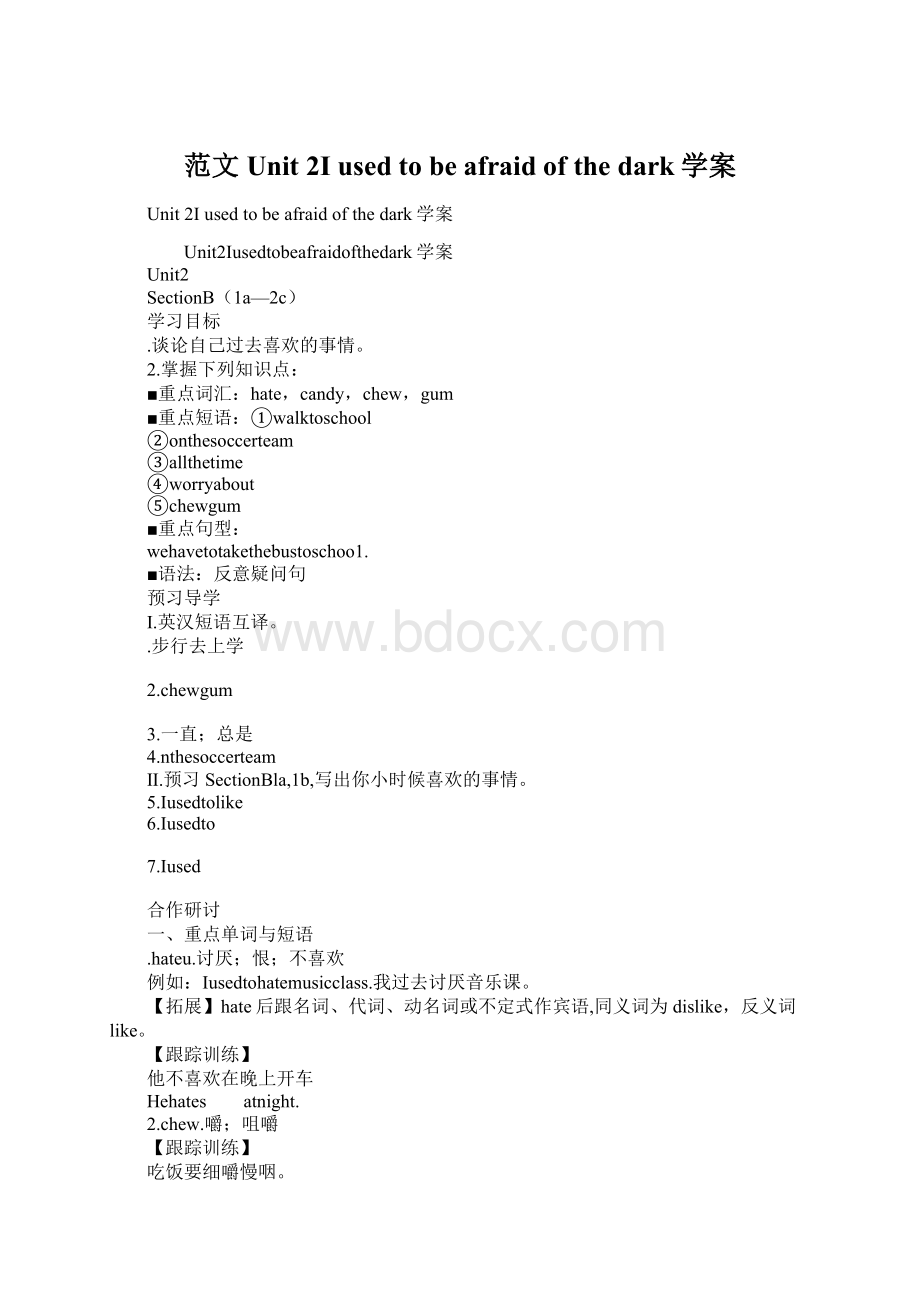范文Unit 2I used to be afraid of the dark学案.docx
《范文Unit 2I used to be afraid of the dark学案.docx》由会员分享,可在线阅读,更多相关《范文Unit 2I used to be afraid of the dark学案.docx(9页珍藏版)》请在冰豆网上搜索。

范文Unit2Iusedtobeafraidofthedark学案
Unit2Iusedtobeafraidofthedark学案
Unit2Iusedtobeafraidofthedark学案
Unit2
SectionB(1a—2c)
学习目标
.谈论自己过去喜欢的事情。
2.掌握下列知识点:
■重点词汇:
hate,candy,chew,gum
■重点短语:
①walktoschool
②onthesoccerteam
③allthetime
④worryabout
⑤chewgum
■重点句型:
wehavetotakethebustoschoo1.
■语法:
反意疑问句
预习导学
Ⅰ.英汉短语互译。
.步行去上学
2.chewgum
3.一直;总是
4.nthesoccerteam
Ⅱ.预习SectionBla,1b,写出你小时候喜欢的事情。
5.Iusedtolike
6.Iusedto
7.Iused
合作研讨
一、重点单词与短语
.hateu.讨厌;恨;不喜欢
例如:
Iusedtohatemusicclass.我过去讨厌音乐课。
【拓展】hate后跟名词、代词、动名词或不定式作宾语,同义词为dislike,反义词like。
【跟踪训练】
他不喜欢在晚上开车
Hehates atnight.
2.chew.嚼;咀嚼
【跟踪训练】
吃饭要细嚼慢咽。
youmust yourfoodwellbeforeyouswallowit.
3.worryabout担心;焦虑
【拓展】与beworriedabout同义
【跟踪训练】
不要担心她。
Don't her.
二、重点句型与语法
■句型
wehavetotakethebustoschoo1.
我们不得不乘公共汽车去上学。
【精解】①haveto意为“必须;不得不”,后跟动词原形。
【辨析】haveto/must
haveto具有客观性,不以人的主观意志为转移;而must强调主观性。
haveto可以用于各种时态,而must则不能。
【跟踪训练】
他不得不早起赶早班车。
He getupearlytocatchtheearlybus。
我们必须学好英语。
we learn English .
【精解】②takethebus意为“乘公共汽车”,“take+the+交通工具”,相当于“by+交通工具”。
【跟踪训练】
gotoschoolbybuseveryday.(同义句转换)
I toschoo1everyday.
■语法
反意疑问句
反意疑问句,表示说话人提出某种情况或建议,询问对方是否同意。
反意疑问句的结构
反意疑问句是由“陈述句+反意疑问部分”构成,其反意疑问部分的结构是:
be动词/助动词/情态动词+主语。
否定形式要用缩略形式。
①主句为肯定陈述句,反意疑问部分为否定形式,即“前肯后否”式。
【跟踪训练】
youareastudem, ?
②主句为否定陈述句,反意疑问部分为肯定形式,即“前否后肯”式。
【跟踪训练】
Hehasn'tfinishedhishomework, ?
反意疑问部分的主语和谓语的确定
①反意疑问部分的主语用代词而不用名词。
【跟踪训练】
mybrotherlikesplayingbasketball, ?
②陈述句中含有否定意义的词,如little,few,never,hardly,nothing,nobody等,其反意疑问部分用肯定形式。
【跟踪训练】
HeknowslittleEnglish, ?
③陈述句是“therebe”结构时,其反意疑问部分用“be+there"。
【跟踪训练】
Thereisapostofficeneartheschool, ?
④以Let's开头的祈使句,反意疑问部分为shallwe;以Letus开头的祈使句,反意疑问部分为willyou;主句为祈使句,反意疑问部分为willyou。
【跟踪训练】
Let'sgohome, ?
Don'tbelateagain, ?
⑤陈述句中含有情态动词must时,若must表示“必须”时,反意疑问部分用needn't。
若must表示推测“一定;想必”之意时,其反意疑问部分的动词应根据must后面的动词来确定。
【跟踪训练】
wemustworkhard, ?
Shemusthavefinishedherhomework, ?
⑥当陈述句为含有宾语从句的主从复合句时,反意疑问部分的动词和主语通常与主句的动词和主语保持一致。
若主句的主语是第一人称I/we,其谓语动词又是think,sup-pose,believe,imagine等,则反意疑问部分的主语和动词应与从句的主语和动词保持一致。
【跟踪训练】
Tomsaidthathewouldvisitchinanextmonth, ?
Ithinkshecansolvetheproblem, ?
反意疑问句的答语
应根据具体的语言环境确定用肯定回答或否定回答,即根据事实回答。
对“前否后肯”式的反意疑问句的回答要注意其回答形式要一致,即肯定用yes,后面的部分用肯定形式,yes译为“不”;否定用No,后面的部分用否定形式,No意为“是的”。
【跟踪训练】
—yourfatherisn'tadoctor,ishe?
- .
当党检测
Ⅰ.根据句意及首字母或汉语提示完成单词
.Iusedtoc gumalot.whataboutyou?
2.一Doyoulike (糖果)?
一No,Idon't.
3.Somestudentsusuallygotoschoolon (步行).
4.Sheusedto (讨厌)gymclass.
5.HeisabasketballP .
Ⅱ.根据汉语提示完成句子
6.Idon't (担心)tests.
7.LiLeioften toschool.
8.She lookafterherlittlebrotherbecausehermotherisn'tathome.
课后练习
Ⅰ.单项选择
(
)1.Tomplaysbasketballwellandheis thebasketballteam.
A.in
B.on
c.at
D.with
(
)2.Ifyouarefamous,peoplewillfollowyou .
A.allthetime
B.thealltimec.a11time
D.timeall
(
)3.Heusedtoplayping-pang, .
A.don'the
B.didn'the
c.wasn'the
D.doesn'the
(
)4.—youarenewhere, .
—yes,Icameherelastyear.
A.doyou
B.don'tyou
c.areyou
D.aren'tyou
(
)5.—Billhadnothingforbreakfastthismorning ?
— ,hegotuptoolate.
A.hadhe;yes
B.hadn'the;yes
c.didhe;No
D.didn'the;No
Ⅱ.阅读理解
Ittookjohnmanymonthstosaveup(积蓄)sevenpounds.Hewantedtobuyanewmodelplaneandwenttotheshopwiththemoney.
ontheway,johnsawalittleboycryingonthecornerofthestreet.“whyareyoucrying?
”johnasked.
“Threebigboystookawayfourpoundsfrommejustnow,”theboysaid.“Iwasonmywaytobuysomeexercisebooks,butIcan't.”
johnthoughtofthesevenpoundsinhispocket.Hethoughtofthemodelplaneandthepoorboy.
johnwantedtowalkaway,buthedidnot.Atlasthegavefourpoundstotheboyandwenthome.
johnfelthappy.Doyouknowwhy?
Itwasbecausethelittleboywashappy.
根据短文内容填空
johnspentmany
6
saving
7
sevenpounds.He
8
tobuyanewmodelplane.onthewaytothe
9
,hesawaboy
0
.Theboy
1
johnthatthreeboyshadtakenawayfourpoundsfromhim,andhecouldn't
2
someexercisebooks.
3
lastjohngave
4
fourpounds.johndidn'tbuythe
5
plane,buthefelthappyallthesame.
6.
7.
8.
9.
0.
1.
2.
3.
4.
5.
Unit2
SectionB(3a—4a)
学习目标:
.谈论自己存在的问题。
2.掌握下列知识点:
■重点词汇:
chat,daily,comic
■重点短语:
①a11day②not...anymore③chatwith④inthelastfewyears⑤thesedays
■重点句型:
①whenIwasyoung,Iusedtohavesomuchtime,butthesedaysIgetupearlyandstayinschoo1a11day.
②BeforeIstartedhighschoo1,Iusedtospenda1otoftimeplayinggameswithmyfriends,butIjustdon'thavethetimeanymore.
预习导学
Ⅰ.英汉短语互译。
.太忙了
2.not...anymore
3.闲聊
4.inthelastfewyears
Ⅱ.阅读SectionB3a部分,回答下列问题。
5.what'sRoseTang'sbiggestproblem?
6.DidRoseTangusetohavesomuchtimewhenshewasyoung?
7.DoesRoseTangmisstheo1ddays?
合作研讨
一、重点单词与短语
.chat认聊天;闲谈
【拓展】chatwithsb意为“和某人聊天”,相当于chattosb.
【跟踪训练】
(1)以前晚饭后我常和奶奶聊天。
Iusedto mygrandmotherafterdinner
2.dailyadj.每日的;日常的
【拓展】以1y结尾的形容词还有:
friendly(友好的),lwely(可爱的;美丽的)等
【跟踪训练】
(2)你的日常生活如何?
Howisyour ?
二、重点句型
.whenIwasyoung,Iusedtohavesomuchtime,butthesedaysIgetupearlyandstayinschoo1a11day.
当我小的时候,我常常有那么多的时间,但是现在我早早起床,整天待在学校里。
【精解】somuch意为“如此多的”,修饰不可数名词。
somany意为“如此多的”,修饰可数名词复数。
【跟踪训练】
我太忙了,我有这么多家庭作业要做。
Iamtoobusy.Ihave homeworktodo.
【拓展】
(1)so....that...意为“如此……以至于……”,引导结果状语从句;sothat意为“以便;为了”,相当于inorderto,引导目的状语从句。
【跟踪训练】
他跑得如此快,我们跟不上他。
Heran quickly wecouldn'tkeepupwithhim
Shegotupearlysothatshecouldcatchtheearlybus.(同义句转换)
Shegotupearly
catchtheearlybus.
【拓展】
(2)“so+助动词+主语”意为“……也是如此”,代替上句提到的情况或事实;“so+主语+助动词”意为“……确实……”,表示赞同。
【跟踪训练】
—TomcanspeakFrench.
— (我也会说).
—LiLeiisgoodatswimming。
— (是呀).
2.BeforeIstartedhighschoo1,Iusedtospenda1otoftimeplayinggameswithmyfriends,butIjustdon'thavethetimeanymore.
在上中学之前,我常常花费大量时间和朋友们一起做游戏,但是现在我再也没有这样的时间了。
【精解】spend意为“花费”时,后跟表示时间或金钱等的单词。
【跟踪训练】
昨天晚上做家庭作业花费了我半小时。
I halfanhour myhomework1astnight.
【辨析】spend/take/cost/pay(for)
spend/take/cost/pay(for)四个单词都有“花费的意思,但用法不同。
①spend主语为“人”,常用句式“sb.+spends+时间/金钱十onsth./(in)doingsth./withsb.”。
②take意为“需要;花费”时,其常用句式“htakes/took+sb.+时间/金钱+todosth.”,“为形式主语,动词不定式todosth.作真正的主语。
③cost意为“花费”时,主语为“物”,常指花费金钱,其常用句式“sth.+cost+sb.+金钱”。
④pay意为“花费”时,主语为“人”,其常用句式“sb.+pay+金钱+for+sth.”。
【跟踪训练】
今年夏天我要和我奶奶度过假期。
I'll myvacation mygrandmotherthissummer.
昨天晚上做家庭作业花费了我半小时。
It mehalfanhour myhome-worklastmight.
这本书花了我十元钱。
Thebook me10yuan.
这本书花了我十元钱。
I 10yuan thebook.
【精解】
(2)notanymore意为“不再”,not应置于be动词或助动词之后,anymore应位于句末。
【拓展】notanymore的同义短语为no1onger,notanylon-ger,nomore,notanymore
【跟踪训练】
她不再住儿了。
She livehere .
当堂检测
Ⅰ.根据句意及首字母或汉语提示完成单词
.Sorry,Ihavenotimetochatwithyou.I'mb now.
2.Ireally (想念)theo1ddays.
3.Howmuchdidyou (花费)onthecDplayer?
Ⅱ.根据汉语提示完成子
4.youaren'tachi1d (不再).youShould1ookafteryourself.
5.we (花费)twohours (完成)theworkyesterday.
6.Sheis (闲聊)withherfriendonthephone.
课后练习
Ⅰ.单项选择
(
)1.—Ihavemanybeautifulstamps.
— .
A.SoIdo
B.SohaveI
c.SodoI
D.Idoso
(
)2.Nowlhavetostayinschoo1 .
A.a11day
B.alltheday
c.a11days
D.a11thedays
(
)3.—How1ongdidittakeyou yourhome-wotkeveryday?
—Abouttwohours.
A.tofinish
B.finishing
c.finished
D.finisheS
(
)4.Hislife a1otinthe1astfewyears.
A.changed
B.changes
c.haschanged
D.hadchanged
(
)5 importantforeveryone Englishwell.
A.It's;to1earn
B.It's;learningc.That's;to1earnD.That'`s;1earning
Ⅱ.根据短文内容,完成已给出首字母的单词,使短文内容通顺完整。
weareveryg
6
thatwangminghasmadegreatprogress.Heusedtob
7
lateforschoo1anddidn’t1istentotheteachersc
8
inclass.Afterschoo1,he1ikedp
9
computergamesandwatchingTV.Hedidn’tdohishomeworkSohis1essonswerebad.Hef
0
inmanysuects.LiPingisagoodboy.Heisg
1
athislessons.Hem
2
friendswithwangPing.Hehelpshimwithhis1essonsandhelpshimw
3
outproblems.Now,withLiPing’shelp,wangminghasbecomei
4
inhislessons.Hestudieshardandfinisheshishomeworkontime.Besides,hegetsonwellwithhisclassmates.Fromthis,weknowthatit’sI
5
forustohelpand1earnfromeachother.
6.
7.
8. 9.
0.
1. 12.
3.
4. 15.